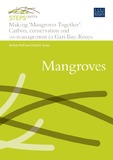Making ‘Mangroves Together’: Carbon, conservation and co-management in Gazi Bay, Kenya
| dc.contributor.author | Huff, Amber | |
| dc.contributor.author | Tonui, Charles | |
| dc.coverage.spatial | Kenya | en |
| dc.date.accessioned | 2017-05-04T09:42:25Z | |
| dc.date.available | 2017-05-04T09:42:25Z | |
| dc.date.issued | 2017-05-03 | |
| dc.identifier.citation | Huff, A. and Tonui, C. (2017) Making 'Mangroves Together': Carbon, conservation and co-management in Gazi Bay, Kenya, STEPS Working Paper 95, Brighton: STEPS Centre | en |
| dc.identifier.isbn | 978-1-78118-370-0 | |
| dc.identifier.uri | https://opendocs.ids.ac.uk/opendocs/handle/20.500.12413/12970 | |
| dc.description.abstract | Market-based strategies are increasingly being framed by highlevel stakeholders as ideal means of responding to environmental problems on various scales. As a result, concepts and mechanisms that link markets to local conservation initiatives such as payments for ecosystem services (PES) schemes, carbon trading and other forms of offsetting, and conservation finance instruments and mechanisms like biodiversity derivatives, water futures, and wetland and species banking have both proliferated and diversified in the past two decades. Market-based conservation is a key component of international initiatives that aim to promote capitalization of pro-environment goods and services and stimulate ‘green’ or pro-environment economic growth. This paper contributes to a growing body of research in political ecology that seeks to enhance our understanding of variegated dynamics and processes around the ‘neoliberalisation of nature’ by exploring empirical dimensions of marketization processes on the ground. We bring together tools and insights from social anthropology, human geography, and science studies (STS) to explore changing property rights, modes of governance and the reconfiguration of control and rights to benefit from natural resources in the context of a unique ‘blue forest’ mangrove conservation project called Mikoko Pamoja based at Gazi Bay in southern coastal Kenya. Mikoko Pamoja is promoted as a ‘community-led’ mangrove conservation project aiming to conserve and enhance local ecosystems and deliver livelihood benefits to local populations whilst mitigating global carbon emissions through the sale of project-based carbon credits on the voluntary carbon market (VCM). Specifically we ask how changing governance relationships, including community co-management of mangrove forests facilitated through Kenya’s Forest Policy reforms, institute marketized environmental management through novel stakeholder alliances and the application of techniques of valuing, trading and consuming nature. Our findings demonstrate the central significance of the ‘community-based’ participatory forest co-management model to the project’s access to mangrove forests for scientific activities and technical assessment, to the project’s mobilisation of informal social institutions for mangrove management and to project branding and marketing of carbon credits. While we conclude that Mikoko Pamoja represents a unique example in the field of VCM projects in which the national and sub-national policy landscape, local governance institutions, and international partner priorities have aligned, our findings also highlight how this particular project’s successes can mask a number of persistent challenges associated with formal comanagement arrangements and issues of equity in marketized conservation more broadly. | en |
| dc.description.sponsorship | ESRC | en |
| dc.language.iso | en | en |
| dc.publisher | ESRC STEPS Centre | en |
| dc.relation.ispartofseries | STEPS Working Papers;95 | |
| dc.rights | Users are welcome to copy, distribute, display, translate or perform this work without written permission subject to the conditions set out in the Creative Commons licence. For any reuse or distribution, you must make clear to others the licence terms of this work. If you use the work, we ask that you reference the STEPS Centre website (www.steps-centre.org) and send a copy of the work or a link to its use online to the following address for our archive: STEPS Centre, University of Sussex, Library Road, Brighton BN1 9RE, UK (steps-centre@ids.ac.uk). | en |
| dc.rights.uri | http://creativecommons.org/licenses/by-nc-nd/3.0/ | en |
| dc.subject | Climate Change | en |
| dc.subject | Environment | en |
| dc.subject | Participation | en |
| dc.subject | Rural Development | en |
| dc.title | Making ‘Mangroves Together’: Carbon, conservation and co-management in Gazi Bay, Kenya | en |
| dc.type | Series paper (non-IDS) | en |
| dc.rights.holder | ESRC STEPS Centre | en |
| rioxxterms.funder | Default funder | en |
| rioxxterms.identifier.project | STEPS Centre | en |
| rioxxterms.version | VoR | en |
| rioxxterms.funder.project | 7360ec74-14f4-4420-af2a-8ca314d07ffe | en |
Files in this item
This item appears in the following Collection(s)
-
ESRC STEPS Centre [225]
Except where otherwise noted, this item's license is described as Users are welcome to copy, distribute, display, translate or perform this work without written permission subject to the conditions set out in the Creative Commons licence. For any reuse or distribution, you must make clear to others the licence terms of this work. If you use the work, we ask that you reference the STEPS Centre website (www.steps-centre.org) and send a copy of the work or a link to its use online to the following address for our archive: STEPS Centre, University of Sussex, Library Road, Brighton BN1 9RE, UK (steps-centre@ids.ac.uk).


